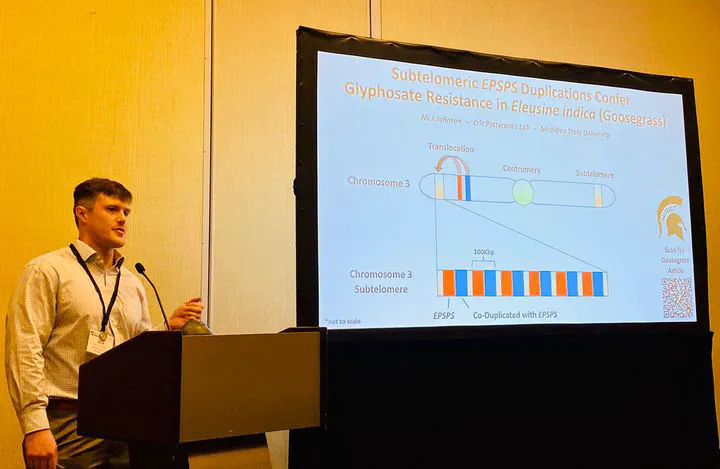Subtelomeric EPSPS duplications confer glyphosate resistance in Eleusine indica
Jan 23, 2024· ,,,,·
0 min read
,,,,·
0 min read
Nicholas A Johnson
Nathan Hall
Chun Zhang
Qin Yu
Eric L Patterson
 Single-slide talk by Nicholas A. Johnson at Weed Science Society of America 2024
Single-slide talk by Nicholas A. Johnson at Weed Science Society of America 2024Abstract
Genomic structural variation (SV) has profound effects on organismal evolution; often serving as a source of novel genetic variation. Gene copy number variation (CNV), one type of SV, has repeatedly been associated with adaptive evolution in eukaryotes, especially with environmental stress. Resistance to the widely used herbicide, glyphosate, has evolved through target-site CNV in many weedy plant species, including the economically important grass, Eleusine indica (goosegrass); however, the origin and mechanism of these CNVs remain elusive in many weed species due to limited genetic and genomic resources. To study this CNV in goosegrass, we present high-quality reference genomes for glyphosate-susceptible and -resistant goosegrass lines and fine-assembles of the duplication of glyphosate’s target site gene 5-enolpyruvylshikimate-3-phosphate synthase (EPSPS). We reveal a unique rearrangement of EPSPS involving chromosome subtelomeres. This discovery adds to the limited knowledge of the importance of subtelomeres as genetic variation generators and provides another unique example for herbicide resistance evolution.
Date
Jan 23, 2024 10:35 AM
Event
Location
Hyatt Regency San Antonio
123 Losoya Street, San Antonio, TX 78205